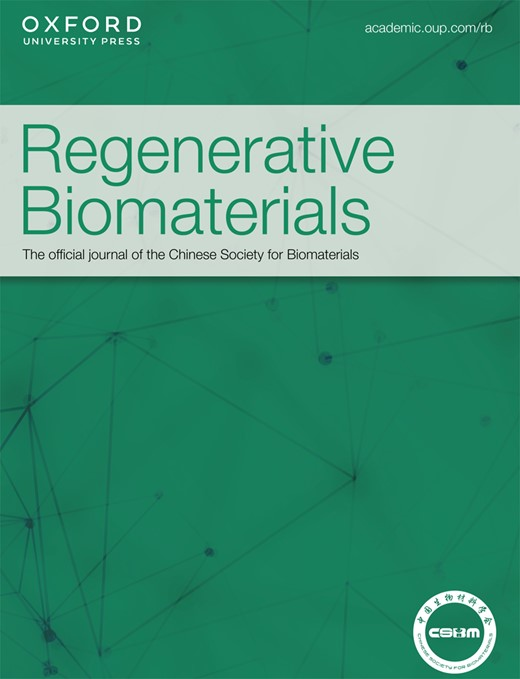时空顺序递送抗菌药和消炎药的 ROS 响应水凝胶用于修复 MRSA 感染的伤口
IF 8.1
1区 医学
Q1 MATERIALS SCIENCE, BIOMATERIALS
引用次数: 0
摘要
对于治疗受 MRSA 感染的伤口,按时空顺序递送抗菌药和消炎药是一种很有前景的策略。本研究通过苯硼酸酯键交联透明质酸接枝3-氨基苯硼酸(HA-PBA)和聚乙烯醇(PVA)制备了ROS响应的HA-PBA/PVA(HPA)水凝胶,实现了两种药物的时空控释,用于治疗MRSA感染的伤口。亲水性抗生素莫西沙星(M)被直接负载在水凝胶中。而具有消炎功能的疏水性姜黄素(Cur)则先与 Pluronic F127(PF)混合形成姜黄素包裹的 PF 胶束(Cur-PF),然后再装载到 HPA 水凝胶中。由于莫西沙星和姜黄素的亲水性和疏水性不同,它们在 HPA 水凝胶中的存在形式也不同,因此最终的 HPA/M&Cur-PF 水凝胶可以实现两种药物的不同时空顺序递送。此外,还测试了水凝胶的溶胀、降解、自愈合、抗菌、抗炎、抗氧化性和生物相容性。最后,在 MRSA 感染的小鼠皮肤伤口中,水凝胶处理组的伤口闭合更快,炎症更少,胶原沉积更多。免疫荧光实验进一步证实,水凝胶通过减少炎症(TNF-α)和促进血管(VEGF)再生,促进了更好的修复。总之,这种 HPA/M&Cur-PF 水凝胶可以时空顺序递送抗菌药和消炎药,在修复 MRSA 感染的皮肤伤口方面显示出巨大的潜力。本文章由计算机程序翻译,如有差异,请以英文原文为准。
ROS-responsive hydrogels with spatiotemporally sequential delivery of antibacterial and anti-inflammatory drugs for the repair of MRSA-infected wounds
For the treatment of MRSA-infected wounds, the spatiotemporally sequential delivery of antibacterial and anti-inflammatory drugs is a promising strategy. In this study, ROS responsive HA-PBA/PVA (HPA) hydrogel was prepared by phenylborate ester bond cross-linking between hyaluronic acid grafted 3-aminophenylboronic acid (HA-PBA) and polyvinyl alcohol (PVA) to achieve spatiotemporally controlled release of two kinds of drug to treat MRSA-infected wound. The hydrophilic antibiotic moxifloxacin (M) was directly loaded in the hydrogel. And hydrophobic curcumin (Cur) with anti-inflammatory function was first mixed with Pluronic F127 (PF) to form curcumin encapsulated PF micelles (Cur-PF), and then loaded into the HPA hydrogel. Due to the different hydrophilic and hydrophobic nature of moxifloxacin and curcumin and their different existing forms in the HPA hydrogel, the final HPA/M&Cur-PF hydrogel can achieve different spatiotemporally sequential delivery of the two drugs. In addition, the swelling, degradation, self-healing, antibacterial, anti-inflammatory, antioxidant property, and biocompatibility of hydrogels were tested. Finally, in the MRSA-infected mouse skin wound, the hydrogel treated group showed faster wound closure, less inflammation and more collagen deposition. Immunofluorescence experiments further confirmed that the hydrogel promoted better repair by reducing inflammation (TNF-α) and promoting vascular (VEGF) regeneration. In conclusion, this HPA/M&Cur-PF hydrogel that can spatiotemporally sequential deliver antibacterial and anti-inflammatory drugs showed great potential for the repair of MRSA-infected skin wounds.
求助全文
通过发布文献求助,成功后即可免费获取论文全文。
去求助
来源期刊

Regenerative Biomaterials
Materials Science-Biomaterials
CiteScore
7.90
自引率
16.40%
发文量
92
审稿时长
10 weeks
期刊介绍:
Regenerative Biomaterials is an international, interdisciplinary, peer-reviewed journal publishing the latest advances in biomaterials and regenerative medicine. The journal provides a forum for the publication of original research papers, reviews, clinical case reports, and commentaries on the topics relevant to the development of advanced regenerative biomaterials concerning novel regenerative technologies and therapeutic approaches for the regeneration and repair of damaged tissues and organs. The interactions of biomaterials with cells and tissue, especially with stem cells, will be of particular focus.
 求助内容:
求助内容: 应助结果提醒方式:
应助结果提醒方式:


